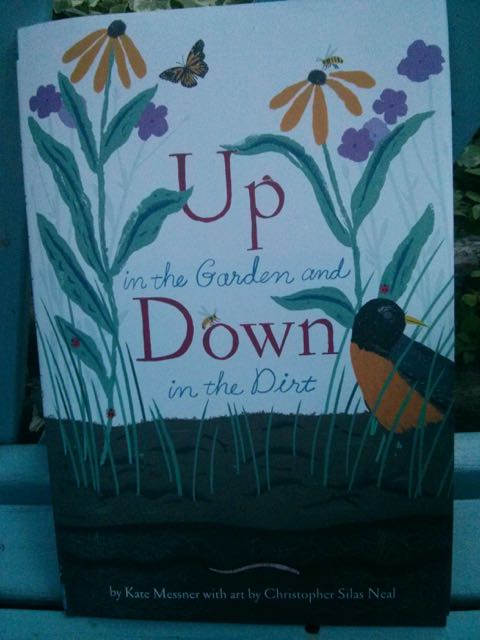March 20, 2025
I Don’t Believe in Seeds
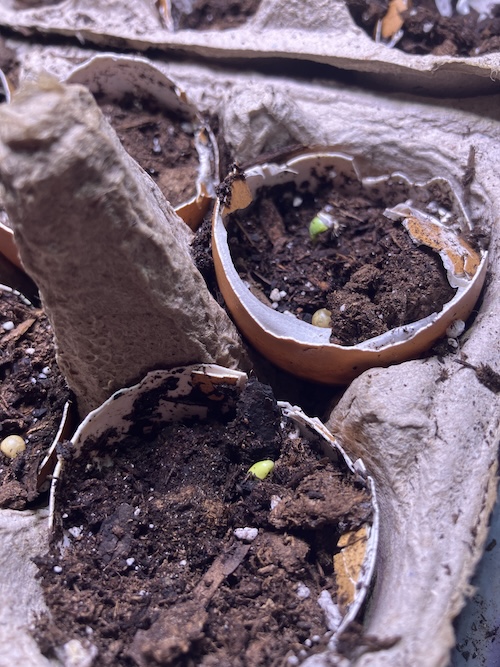
I don’t believe in seeds. I just can’t fathom the fact of what happens when you plant them, no matter how many times I’ve watched the miracle happen, which it always does, and it’s still never not blown my mind. That new life is possible*, how this can turn into that, the ordinary miracle. I still don’t believe it, I can’t. I mean, not so much that I don’t sow seeds every single spring, because I do, the most hopeful gesture I ever enact. I remember how counter-intuitive it felt to sow seeds in the darkness of March and April 2020, how beside-the-point, and even pointless, but I did it anyway, which felt daring and subversive in the depths of my anxiety, to imagine such a thing as a future. I like the hope and the promise therein, but I still don’t believe it, I never do.
Which means that when I do plant seeds, I go overboard. What are the odds, I consider, that a single seed is ever going to sprout? It’s a gamble, so I might as well sow five of them, maybe ten. What kind of magic is this, from a fairy tale, it seems like, spinning straw into gold, growing a single speck into a snapdragon, a gangling plant whose blooms I’ll be clipping until into November. To sow seeds is to take the long view, to have vision, to have faith, except I don’t, as we’ve established. Not really. Not enough that I can simply trust, instead hedging my bets, an entire handful of snapdragon seeds flung into the soil, because what if I was measured about it and then nothing happened?
Lately, I’ve been thinking a lot about faith, about notions of A faith, and about how useful and comforting it would be to have such a thing at this moment. To have a sense of the world and in justice and progress that had not completely been turned upside down and inside out, leaving me wondering if I really know the world at all, what I ever knew about people, and progress, and what the project of these lives we’re weaving together. I watch the world through my news feeds with terror and dread, so much grief and sadness, and I long for something firm to hold onto. I want to keep believing in people, and possibility, in this beautiful world and for our little place in it, and good things being possible.
But I guess that’s what faith is, when it’s hard to believe, but you do it anyway. When we sow those seeds, even when it seems impossible that they’ll ever turn into anything. And what if any doubt we have is a reason to chuck in a handful of seeds, instead of permission to give up sowing altogether?What if sowing seeds shows us that miracles happen all the time?
I woke up this morning, the first day of spring, to find that the seeds I’d planted on Sunday evening had already begun. After a beautiful morning singing songs of peace and joy, I came home and dove into edits on my fourth novel, which will be coming your way in a year less three days.**
I still don’t believe in seeds, and yet. Here we are.
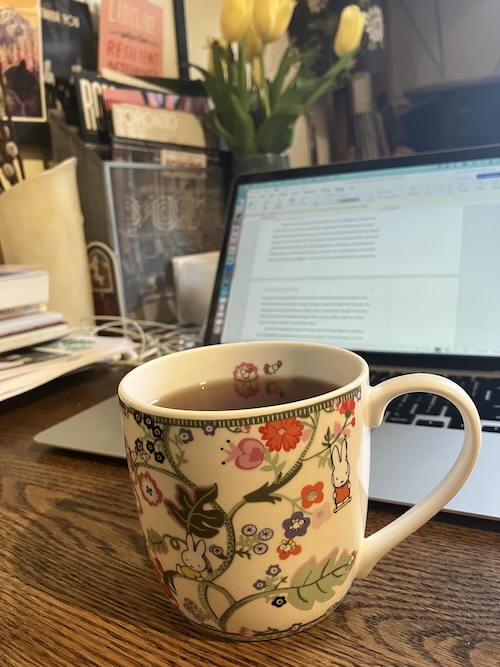
*Not unrelated: I also can’t believe that my children exist. Like, what even is up with that? Where did they come from and how do they just keep getting more and more magnificent all the time?
**Which is exactly five years TO THE DAY after I first wrote about the project: “Making: A new novel that’s inspired by Barbara Pym’s books, and I just hit 10,000 words. It might not be good, it might never be published, but my goodness, am I having a good time.”
October 7, 2024
The Garden Against Time, by Olivia Laing
“How strange time is. The same patterns keep recurring, a helical sequence of war and sickness, from out of which emerged the same green-veined dream.”
For a book that’s about her own backyard, Olivia Laing’s THE GARDEN AGAINST TIME: IN SEARCH OF A COMMON PARADISE takes her reader everywhere and back through time as she tells the story of her restoration of an 18th century walled garden begun when she and her partner move to Suffolk in 2020, a year that becomes “that year.” As she moves through her own plague seasons, she draws connections to gardens in the minds of Milton (PARADISE LOST) and rural poet John Clare, changes and trends in English landscaping ( a word that, she tells us, began with art and paintings), of how the mid-Atlantic slave-trade was the foundation of so much wealth that shaped the English landscape (I am also reading Tanya Talaga’s THE KNOWING, from which I learn that those very same investors were reaping the rewards of the North American fur trades that would decimate the continent’s Indigenous peoples), and how gardens have also been at the forefront of movements committed to imagining better ways of organizing society, which seems especially pressing to consider in the sweltering summer of 2022 as parts of the UK burned and watering her garden, Laing thought, seemed like an irresponsible indulgence. And how new life took root in the brutal bomb sites of London after the Blitz, so many of these sites turned into parks, and she casts her mind too back to Mark Rumary, the famed UK garden designer who’d once owned her home (and lived with his partner back when, a neighbour tells her, “it wasn’t good to be gay”) and whose vision is everywhere in the garden still, Laing reflecting on her own childhood growing up with a gay parent in the 1980s, and what the garden must have meant to both of them as place of freedom and belonging. And there’s so much more than that, every single page bringing fascinating rewards and gorgeous insight, doses of hard reality coupled with vision and hope. The garden is never simply this or that, instead the garden is a place for both, and, and for the remarkable persistence of living things (gardeners among them).
April 19, 2023
The Story of My Garden

There were a few seasons during which I might have told you that I had a greenish thumb, more than fifteen years ago now, back when I was a newlywed and my husband and I lived in a second floor apartment near College and Ossington. I’d never had a garden before, but, with the help of our downstairs neighbour, we planted one in the backyard where tomatoes already grew, their vines winding around the cinderblocks and other construction debris that littered our yard.
The tomatoes should have been a sign, but I didn’t know enough to know that…
(Read the rest of my piece in the Harbord Village Gardeners e-newsletter!)
May 13, 2022
Before the Beginning

My favourite time is before anything happens, when it’s all just possibility, because possibility is something that you might even imagine you can hold in your hands, unlike everything that happens after that. (The force that through the green fuse drives the flower…) My favourite weekend day of Thursday, and my favourite month is April, even though April is horrible (which we managed to escape this year with a week in England and getting Covid after that…), because when it’s April it means you’ve still got May and June before you, which means you’ve still got all of summer. The moment before it all gets started, that upstoppable motion, when the green shoots exploding, go, go, go. And forsythia turns into lilacs turns into cosmos, and weeds start growing up from the cracks in the sidewalks, and it seems impossible that my garden was ever just an assemblage of buckets of dirt. Which it was until last Sunday, when I sowed a whole bunch of flower seeds in the pots all up the stairs, though I can no longer remember into which pot went what, but we’ll find out soon enough. Seedlings arriving yesterday from one of my kids’ school fundraisers—we’ve got lettuce, and basil, two strawberry plants, a sunflower. My one perennial that survived the winter throwing up a bit of green, and it’s all starting to happen, but yes, I love it most (because I love it all) just before anything does.
June 12, 2017
Grounds For Hope

On Saturday night somebody attacked our lavender bush with a sharp stick, clearly with the intent of destroying it. Yes, the lavender that we bought two years ago in order to replace the shrub that someone tore out of our garden in a (we think) drunken rage. It was discovered Sunday morning half dug up, roots torn, sad and limp. Particularly sad because it had been so lush, flowers just on the verge of blooming. Poor little lavender, and we speculated about the culprit—was it a man who (like someone rather close to home) had become frustrated with his wife’s compulsion to add lavender to everything, and just decided he couldn’t take it anymore, every single bite of everything tasting more than a little like perfume? Or someone further over the edge, plagued by demonic lavender visions, a stake in the root the only real solution?
Anyway, we have found that tending a community garden is an excellent exercise in living with the world, in coming to terms with its realities. What kind of asshole would so something like that? But the thing about the world is that there are all kinds of assholes, and accepting this is part of life. And so we focus instead on other things, that we have a community gardening group to whom we could direct our gardening emergency questions: Can This Lavender Be Saved? I got an email back in a half hour or so, that depending on root damage the plant could possibly survive by being trimmed back and repotted in a small container for the summer and given a restful summer. We got on it straightaway and the lavender looks much less sad now. Also, the city is donating plants for community gardeners and we’ll be able to order a new lavender for our planter. All is not lost. We’ll keep tending our garden, and putting up with the jerks that try to wreck it and/or steal our plants is all part of the experience. We’ll keep planting our seeds and helping them grow, because this is the world we’ve got, and when it isn’t awful, it’s really beautiful. The one and only too.
Today marks a year since the Pulse nightclub shooting in Orlando, an event that was terrible in itself but also marks the beginning of what I think of now as The Very Bad Time, one that hasn’t yet concluded. Jo Cox’s murder, then Brexit. I remember walking home from soccer last summer on the most beautiful evening (there were rainbows) and then hearing news of atrocities in Nice. The election in November, so much awfulness since. And more devastation in London and Manchester these last few weeks, each of these events strung like beads on a terrible, awful string. It is a difficult time to be in the world. Life is so hard and random, even when there aren’t maniacs committing acts of murder on busy streets. There is uncertainty, and sadness, and so much loss. So much awful commemoration.
Such much juxtaposition too. How do you make sense of it? I remember the Pulse Nightclub news at the end of the most splendid summer day, a day that smelled like sunscreen, tasted like ice cream, and sounded like the splash of waves on the beach. It was a day that became legend in our family, because we hadn’t had a plan at all—it just happened. And then yesterday we wanted to do it again, to return to the Beaches Arts and Crafts Sale, to have a picnic in Kew Gardens, play on the climbers, have dinner on Queen Street, and so spend so much time that time slows down hanging out beside the lake, collecting beach glass, and looking for other interesting things.
Efforts to orchestrate good days can easily go a bit wrong. There has be room for them to happen, and I was thinking about this yesterday as we planned our day. (“Isn’t it nice to think that tomorrow is a new day with no terrorist attacks in it yet?”) Plus, I was wondering about the beach. Water levels are at record highs—more dread of course, global warming. Will there even be a beach? I’d seen photos of the lake right up against the boardwalk.
I love beach glass. I love that the intersection of humans and nature can result in something so precious and beautiful. I love that the story isn’t all bad. I love that beach glass by definition is sharp edges worn smooth, that collecting it is an exercise in paying attention. We started collecting beach glass last summer, to what end I’m not sure yet, perhaps just for the sake of having it. I usually resist the urge to own things I find in nature, but beach glass is different, and I don’t know that the lake really minds if we take it away.
And the thing I learned yesterday is that high water levels and diminished beach equals an abundance of beach glass—it’s all been swept ashore. We found loads of it, huge pieces, a veritable treasure trove. I think too about the high water levels in the context of Leanne Betasamosake Simpson’s “Big Water,” about the lake reclaiming itself. The positive ecological benefits of what’s happening, all the things that might grow, might be discovered.
In spite of everything, and maybe even because of everything: we had a very good day.

“To me, the grounds for hope are simply that we don’t know what will happen next, and that the unlikely and the unimaginable transpire quite regularly.” —Rebecca Solnit, “Woolf’s Darkness”
July 3, 2016
Summer Starts

There is no better way to travel then on trains, where the leg room is ample and there is so much time to read. When we booked this weekend away, the train journey itself was the destination, but we had to arrive somewhere, so we chose Ottawa, where we have best cousin-friends and even other friends, and cousin-friends who were kind enough to offer us a place to stay. And it was Canada Day Weekend, so what better place to be…even if the place we mean to be specifically on Canada Day is our cousin’s beautiful backyard across the river in Gatineau. And it really was amazing.

As we’d hoped, the train journey was a pleasure. I had more time to read than I’ve had in weeks. I finished Rich and Pretty, by Rumaan Alam, which I liked so much and will be writing about, and started Signal to Noise, by Silvia Moreno-Garcia, which was lovely and so much fun. They also had my favourite kind of tea on sale (Sloane Tea’s Heavenly Cream) and so all was right with the world.
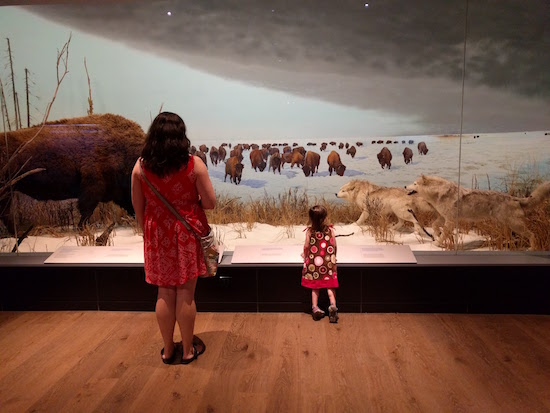
It was such a nice weekend—the children had children to play with and I got to spend time with some of my favourite people. We had an excellent time with our cousins, and met up with my dear friends Rebecca who took us to the Museum of Nature, and last night I got to visit with my 49thShelf comrades who I’ve been working so happily with for years but have only ever hung out with a handful of times. Apart from one traumatic episode of carsickness (not mine) and the night the children took turns waking up every twenty minutes, it was a perfect long long weekend. I also learned that it is possible to eat my limit in cheetos and potato chips, which I had never suspected. Also that it is probably inadvisable to start drinking before noon.
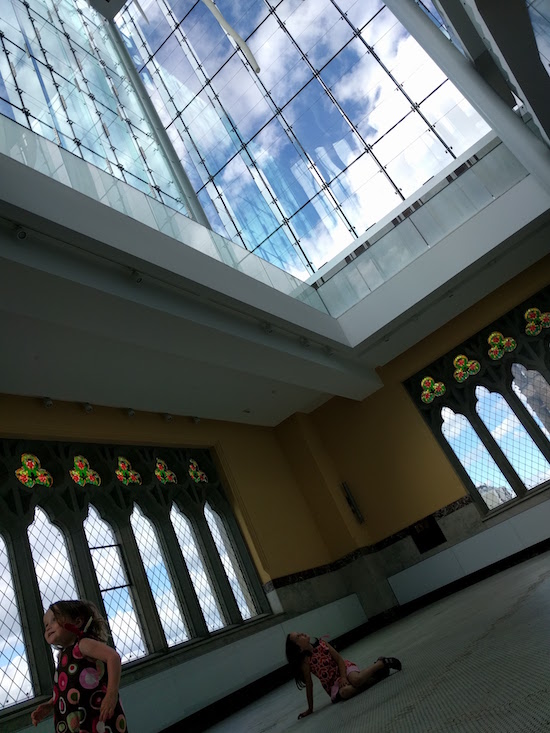
We came home today, another good trip, this time with me reading Nathan Whitlock’s Congratulations on Everything, which I am really enjoying, I also started reading the graphic novel of A Wrinkle in Time with Harriet, which we will continue this week. And we arrived home to find that our marigolds have finally bloomed, third generation. We planted them a couple of months back in our community planter, and have been waiting for the flowers to emerge. (Sadly, our lupines didn’t make it.) Summer is finally here proper, what with school out, and even 49thShelf’s Fall Fiction Preview being up (which is my main project for June), and my work days shift with the children being home. I’ve also decided to write a draft of a novel this summer, which is only going to make a tricky situation trickier, but who doesn’t like tricks? We shall see. We will do our best. And there will also be ice cream and holidays and barbecues and sand between our toes, and splash pads and ferry rides and picnics and pools and flowers. It will all go by so fast.
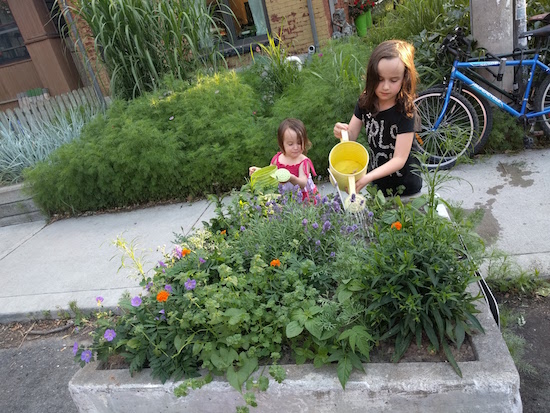
August 19, 2015
In the continuing story of our garden planter
In the continuing story of our community garden planter, it appears that fairies have suddenly and mysteriously set up shop there.
July 16, 2015
Up in the Garden and Down in the Dirt
We went to Parentbooks today to buy a birthday present for Harriet’s friend, and their gorgeous summer books table drew me right in. We ended up buying Up in the Garden and Down in the Dirt, by Kate Messner and Christopher Silas Neal, because it seemed a wonderful companion to Weeds Find a Way, because the illustrations are gorgeous, and because it was so perfectly in tune with our familial zeitgeist of late, which is all butterflies (which Iris calls “fuff-eyes”), watering cans, weeding, and getting up to our elbows in soil.
The story begins in the springtime, the earth just waking up and the crocuses poking through. Neal’s illustrations show that it’s not just up in the garden where the action is happening, but that underground a whole world exists that helps the plants to flourish.
My favourite thing about the book is how the illustrations convey the momentum of the summer garden, which is never the same two days, one plant replacing another. From crocuses, to forsythia, to magnolias, to lilacs, to irises, to linden blossoms, and onto cosmos. It’s like time, spilling over, uncontainable. The kind of thing I never noticed before I started paying attention.
Messner shows the garden as a place of fun and play as well as labour, her young protagonist cooling off from the summer heat by being sprayed by her Nana’s garden hose. While, “Down in the dirt, water soaks deep. Roots drink it in, and a long legged spider stilt-walks over the streams.”
The silhouettes at the end are particularly striking, showing that the nocturnal world—bats!—has its own role to play in helping with the garden. On the next page, there is even a skunk, an animal which—according to the book’s fascinating glossary—is actually a garden helper. Who knew? “Like bats, skunks are nighttime predators that gobble garden pests after dark. Skunks love grubs and slugs.” Ants too—I had no idea. They help to pollinate plants and air the soil with their tunnelling. Harriet and I were both gripped by these facts. It is nice to find a book that can teach new things to two readers who are thirty years apart.
By the end of the book, it is fall, harvest time. Much of the action is taking place underground again, as the pumpkins are nearly ready and the cold is near. And in winter, the story tells us, “a whole new garden sleeps down in the dirt,” the tunnels and nests and animals and insects underground drawn to resemble flowers and vines in an abstract sense—pictorial subtext. It’s wonderful.
Wonderful too the way that the book makes the connection between gardens and books and reading so clear.
July 14, 2015
Nature is as careless as it is bountiful
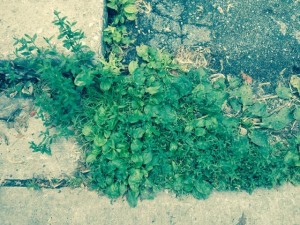 “For nightmare, you eat wild carrot, which is Queen Anne’s lace, or you chew the black stamens of the male peony. But it was too late for prevention, and there is no cure. What root or seed will erase that scene from my mind? Fool, I thought; child, you child, you ignorant, innocent fool. What did you expect to see—angels? For it was understood in the dream that the bed full of fish was my own fault, that if I had turned away from the mating moths the hatching of their eggs wouldn’t have happened, or at least would have happened in secret, elsewhere. I brought it upon my self, this slither, this swarm.
“For nightmare, you eat wild carrot, which is Queen Anne’s lace, or you chew the black stamens of the male peony. But it was too late for prevention, and there is no cure. What root or seed will erase that scene from my mind? Fool, I thought; child, you child, you ignorant, innocent fool. What did you expect to see—angels? For it was understood in the dream that the bed full of fish was my own fault, that if I had turned away from the mating moths the hatching of their eggs wouldn’t have happened, or at least would have happened in secret, elsewhere. I brought it upon my self, this slither, this swarm.
I don’t know what it is about fecundity that so appalls. I supposed it is the teeming evidence that birth and growth, which we value, are ubiquitous and blind, that life itself is so astonishingly cheap, that nature is as careless as it is bountiful…” –Annie Dillard, Pilgrim at Tinker Creek
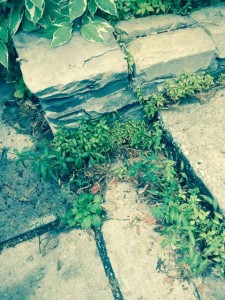 Although Dillard concedes that fecundity is not quite so appalling with plants. She goes on to report, with amazement, a fifteen-foot-long tree growing from the corner of a garage roof, “rooted in and living on ‘dust and cinders.'” I had forgotten about her relative comfort with, her admiration for exploding botanicals, because it’s around this time of the summer every when I spy life coming up through the cracks in the sidewalk that I think about her comment on the appallingness of fecundity—something awful in both senses of the word. When summer throws off its harness, asserting the wild. We are no tamers of it, any of us, and concrete is only incidental. The whole world is bursting with green.
Although Dillard concedes that fecundity is not quite so appalling with plants. She goes on to report, with amazement, a fifteen-foot-long tree growing from the corner of a garage roof, “rooted in and living on ‘dust and cinders.'” I had forgotten about her relative comfort with, her admiration for exploding botanicals, because it’s around this time of the summer every when I spy life coming up through the cracks in the sidewalk that I think about her comment on the appallingness of fecundity—something awful in both senses of the word. When summer throws off its harness, asserting the wild. We are no tamers of it, any of us, and concrete is only incidental. The whole world is bursting with green.
Though I am not sure there is anything careless about it. I have never encountered a force more determined.
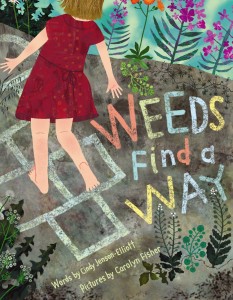 So it seemed like as good a time as any to get Weeds Find a Way out of the library, a book I recall hearing about last year when it came out but hadn’t read yet. The writer, Cindy Jensen-Elliott as full of wonder and amazement as Dillard is when it comes to the tenacity of weeds, their adaptive knack. Carolyn Fisher’s illustrations are beautiful, the book’s unique design bringing text and images together in a playful, gorgeous and illuminating experience. A glossary at the end of the book highlighting a number of common weeds, weeds so common as to be obscure if (to steal a line from poet Mary Ruefle via Heidi Julavits in The Folded Clock) “we can extend the meaning of obscure to be mean covered up by dailiness.” And who doesn’t love a book with a glossary?
So it seemed like as good a time as any to get Weeds Find a Way out of the library, a book I recall hearing about last year when it came out but hadn’t read yet. The writer, Cindy Jensen-Elliott as full of wonder and amazement as Dillard is when it comes to the tenacity of weeds, their adaptive knack. Carolyn Fisher’s illustrations are beautiful, the book’s unique design bringing text and images together in a playful, gorgeous and illuminating experience. A glossary at the end of the book highlighting a number of common weeds, weeds so common as to be obscure if (to steal a line from poet Mary Ruefle via Heidi Julavits in The Folded Clock) “we can extend the meaning of obscure to be mean covered up by dailiness.” And who doesn’t love a book with a glossary?
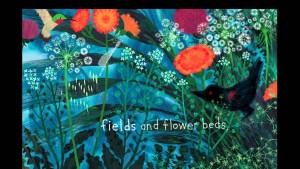 “Wild carrot (Daucus carota) is also known as Queen Anne’s lace. It is said to have gotten its nickname when Queen Anne of England visited Denmark and challenged the ladies there to create lace as fine as the flower of the wild carrot.”
“Wild carrot (Daucus carota) is also known as Queen Anne’s lace. It is said to have gotten its nickname when Queen Anne of England visited Denmark and challenged the ladies there to create lace as fine as the flower of the wild carrot.”
Which you can also eat for nightmare, apparently. Who knew?
July 1, 2015
A Little Lesson
Every time you make a garden, some asshole is going to come along and try to wreck it.
Which is only a reason to garden harder. Bring on the pollinators.
We continue to insist that the world is a beautiful place.


